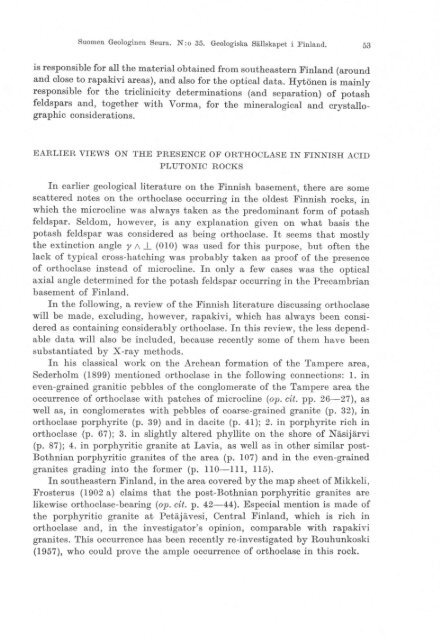COMMISSION GEOLOGIOUE - Arkisto.gsf.fi
COMMISSION GEOLOGIOUE - Arkisto.gsf.fi
COMMISSION GEOLOGIOUE - Arkisto.gsf.fi
You also want an ePaper? Increase the reach of your titles
YUMPU automatically turns print PDFs into web optimized ePapers that Google loves.
Suomen Geologinen Seura. N: 0 35. Geologiska Sällskapet i Finland. 53<br />
is responsible for all the material obtained from southeastern Finland (around<br />
and close to rapakivi areas), and also for the optical data. Hytönen is mainly<br />
responsible for the triclinicity determinations (and separation) of potash<br />
feldspars and, together with Vorma, for the mineralogical and crystallographic<br />
considerations.<br />
EARLIER VIEWS ON THE PRESENCE OF ORTHOCLASE IN FINNISH ACID<br />
PL UTONIC ROCKS<br />
In earlier geological literature on the Finnish basement, there are some<br />
scattered notes on the orthoclase occurring in the oldest Finnish rocks, in<br />
which the microcline was always taken as the predominant form of potash<br />
feldspar. Seldom, however, is any explanation given on what basis the<br />
potash feldspar was considered as being orthoclase. It seems that mostly<br />
the extinction angle y 1\ ..!.. (010) was used for this purpose, but often the<br />
lack of typical cross-hatching was probably taken as proof of the presence<br />
of orthoclase instead of microcline. In only a few cases was the optical<br />
axial angle determined for the potash feldspar occurring in the Precambrian<br />
basement of Finland.<br />
In the following, a review of the Finnish literature discussing orthoclase<br />
will be made, excluding, however, rapakivi, which has always been considered<br />
as containing considerably orthoclase. In this review, the less dependable<br />
data will also be included, because l'ecently some of them have been<br />
substantiated by X-ray methods.<br />
In his classical work on the Archean formation of the Tampere area,<br />
Sederholm (1899) mentioned orthoclase in the following connections: 1. in<br />
even-grained granitic pebbles of the conglomerate of the Tampere area the<br />
occurrence of orthoclase with patches of micl'ocline (op. eit. pp. 26-27), as<br />
weIl as, in conglomerates with pebbles of coarse-grained granite (p. 32), in<br />
orthoclase porphyrite (p. 39) and in da ci te (p. 41); 2. in porphyrite rich in<br />
orthoclase (p. 67); 3. in slightly altered phyllite on the shore of Näsijärvi<br />
(p. 87); 4. in porphyritic granite at Lavia, as weIl as in other similar post<br />
Bothnian porphyritic granites of the area (p. 107) and in the even-grained<br />
granites grading into the former (p. 1l0-11l, 115).<br />
In southeastern Finland, in the area covered by the map sheet of Mikkeli,<br />
Frosterus (1902 a) claims that the post-Bothnian porphyritic granites are<br />
likewise orthoclase-bearing (op. eit. p. 42-44). Especial mention is made of<br />
the porphyritic granite at Petäjävesi, Central Finland, which is rich in<br />
orthoclase and, in the investigator's opinion, comparable with rapakivi<br />
granites. This occurrence has been recently re-investigated by Rouhunkoski<br />
(1957), who could prove the ample occurrence of orthoclase in this rock.
















